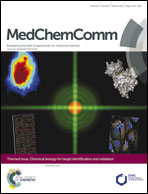Affinity-based target identification for bioactive small molecules
Abstract
Identification of the cellular targets of bioactive small molecules is a crucial step in drug discovery and chemical genetics. Classical affinity purification with small-molecule affinity probes remains the most common approach, but it remains a considerable challenge. To overcome various drawbacks in probe preparation, nonspecific interactions, and the sensitivity of target detection, new methods and techniques are being developed, such as a nonselective universal coupling method based on a photo-affinity reaction, which enables introduction of a variety of small molecules to a solid support without chemical modification to generate small-molecule affinity probes. Here, we review recent progress in affinity-based approaches for small-molecule target identification with a focus on affinity purification.


 Please wait while we load your content...
Please wait while we load your content...